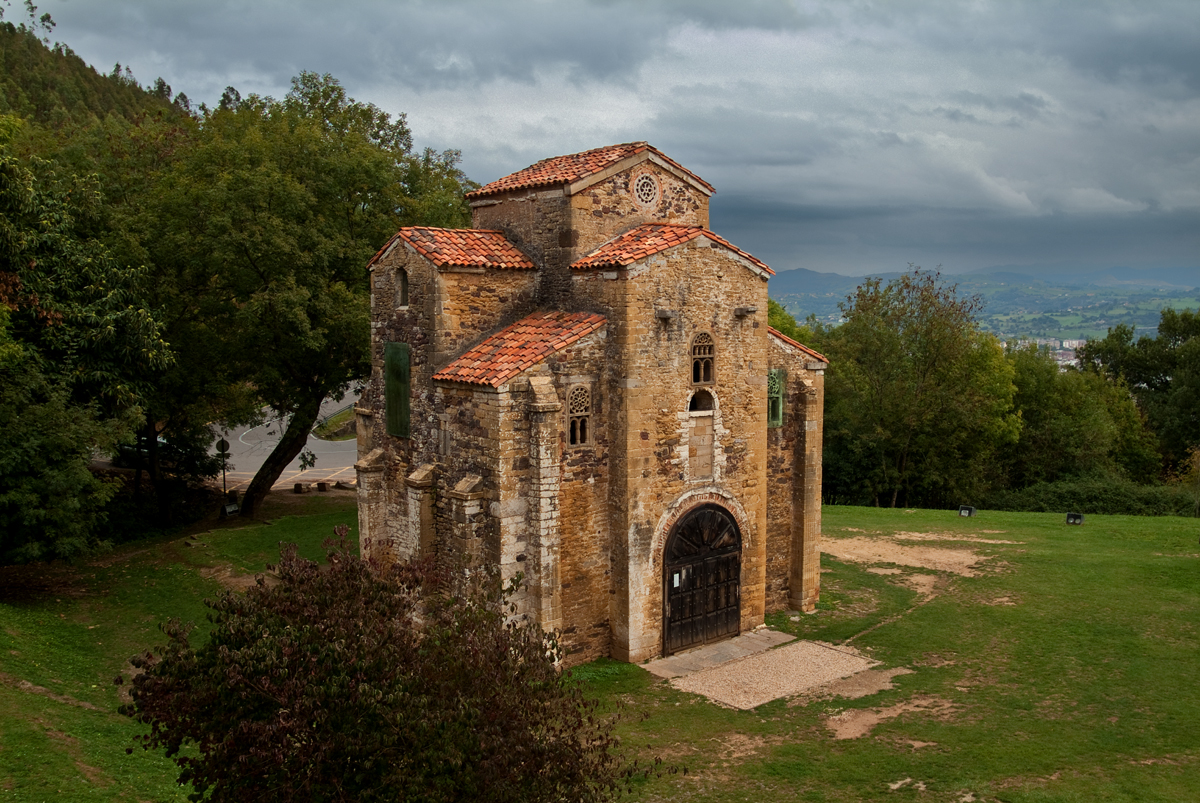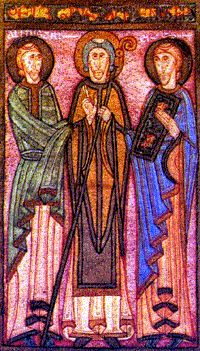|
Cathedral Of San Salvador, Oviedo
The Metropolitan Cathedral Basilica of the Holy Saviour or Cathedral of San Salvador (, ) is a Roman Catholic church and minor basilica in the centre of Oviedo, in the Asturias region of northern Spain. The Cathedral of San Salvador of Oviedo today displays an array of architectural styles, from Pre-Romanesque to Baroque, including Romanesque, Gothic and Renaissance parts. History The church began as a large Pre-Romanesque basilica in the present location of the Gothic cathedral, but nothing more is known about that first building, built by order of King Alfonso II of Asturias. The cathedral was founded by King Fruela I of Asturias in 781 AD, and enlarged in 802 by his son Alfonso II of Asturias known as ''Alfonso the Chaste'', who made Oviedo the capital of Kingdom of Asturias, and resided in Oviedo with his court. He created the See of Oviedo in 810. The present edifice was begun by Bishop Gutierre of Toledo in 1388, and the tower added by Cardinal Francisco Mendoza de ... [...More Info...] [...Related Items...] OR: [Wikipedia] [Google] [Baidu] |
Oviedo
Oviedo () or Uviéu (Asturian language, Asturian: ) is the capital city of the Principality of Asturias in northern Spain and the administrative and commercial centre of the region. It is also the name of the municipality that contains the city. Oviedo is located approximately southwest of Gijón and southeast of Avilés, both of which lie on the shoreline of the Bay of Biscay. Oviedo's proximity to the ocean of less than in combination with its elevated position with areas of the city more than 300 metres above sea level causes the city to have a maritime climate, in spite of its not being located on the shoreline itself. History The Kingdom of Asturias began in 720, with the Visigothic aristocrat Pelagius of Asturias, Pelagius's (685–737) revolt against the Muslims who at the time were occupying most of the Iberian Peninsula. The Umayyad conquest of Hispania, Moorish invasion that began in 711 had taken control of most of the peninsula, until the revolt in the nort ... [...More Info...] [...Related Items...] OR: [Wikipedia] [Google] [Baidu] |
Asturias
Asturias (; ; ) officially the Principality of Asturias, is an autonomous communities of Spain, autonomous community in northwest Spain. It is coextensive with the provinces of Spain, province of Asturias and contains some of the territory that was part of the larger Kingdom of Asturias in the Middle Ages. Divided into eight Comarcas of Asturias, ''comarcas'' (counties), the autonomous community of Asturias is bordered by Cantabria to the east, by Province of León, León (Castile and León) to the south, by Province of Lugo, Lugo (Galicia (Spain), Galicia) to the west, and by the Cantabrian Sea to the north. Asturias is situated in a mountainous setting with vast greenery and lush vegetation, making it part of Green Spain. The region has a oceanic climate, maritime climate. It receives plenty of annual rainfall and little sunshine by Spanish standards and has very moderate seasons, most often averaging in the lower 20s Celsius. Heat waves are rare due to mountains blocking s ... [...More Info...] [...Related Items...] OR: [Wikipedia] [Google] [Baidu] |
Juan De Cerecedo
''Juan'' is a given name, the Spanish and Manx versions of ''John''. The name is of Hebrew origin and has the meaning "God has been gracious." It is very common in Spain and in other Spanish-speaking countries around the world and in the Philippines, and also in the Isle of Man (pronounced differently). The name is becoming popular around the world and can be pronounced differently according that region. In Spanish, the diminutive form (equivalent to ''Johnny'') is , with feminine form (comparable to ''Jane'', ''Joan'', or ''Joanna'') , and feminine diminutive (equivalent to ''Janet'', ''Janey'', ''Joanie'', etc.). Chinese terms * ( or 娟, 隽) 'beautiful, graceful' is a common given name for Chinese women. * () The Chinese character 卷, which in Mandarin is almost homophonic with the characters for the female name, is a division of a traditional Chinese manuscript or book and can be translated as 'fascicle', 'scroll', 'chapter', or 'volume'. Notable people * Juan (foo ... [...More Info...] [...Related Items...] OR: [Wikipedia] [Google] [Baidu] |
Pedro De Bunyeres
Pedro is a masculine given name. Pedro is the Spanish, Portuguese, and Galician name for '' Peter''. Its French equivalent is Pierre while its English and Germanic form is Peter. The counterpart patronymic surname of the name Pedro, meaning "son of Peter" (compared with the English surname Peterson) is Pérez in Spanish, Peres in Galician and Portuguese, Pires also in Portuguese, and Peiris in coastal area of Sri Lanka (where it originated from the Portuguese version), with all ultimately meaning "son of Pero". The name Pedro is derived via the Latin word "petra", from the Greek word "η πέτρα" meaning "stone, rock". The name Peter itself is a translation of the Aramaic ''Kephas'' or '' Cephas'' meaning "stone". An alternative archaic variant is Pero. Notable people with the name Pedro include: Monarchs, mononymously *Pedro I of Portugal *Pedro II of Portugal *Pedro III of Portugal *Pedro IV of Portugal, also Pedro I of Brazil *Pedro V of Portugal *Pedro II ... [...More Info...] [...Related Items...] OR: [Wikipedia] [Google] [Baidu] |
Diego De Muros (bishop Of Oviedo)
Diego de Muros (died 18 August 1525) was a Roman Catholic prelate who served as Bishop of Oviedo (1512–1525) and Bishop of Mondoñedo (1505–1512)."Bishop Diego de Muros" ''Catholic-Hierarchy.org''. David M. Cheney. Retrieved March 21, 2016 He was one of three bishops of Spain who served contemporaneously, the others being Diego de Muros (Bishop of Islas Canarias) and Diego de Muros (bishop of Ciudad Rodrigo). Biography On 4 April 1505, Diego de Muros was appointed during the papacy of Pope Julius II as Bishop of Mondoñedo. On 1 October 1512, Diego de Muros was appointed during the papacy of Pope Julius II as Bishop of Oviedo. He served as Bishop of Oviedo until his death on 18 August 1525.[...More Info...] [...Related Items...] OR: [Wikipedia] [Google] [Baidu] |
Diego Ramirez De Guzmán
Diego is a Spanish masculine given name. The Portuguese equivalent is Diogo. The etymology of Diego is disputed, with two major origin hypotheses: ''Tiago'' and ''Didacus''. The name also has several patronymic derivations, listed below. Etymology ''Tiago'' hypothesis Diego has long been interpreted as variant of ''Tiago'' (also spelled as '' Thiago''), an abbreviation of ''Santiago'', from the older ''Sant Yago'' "Saint Jacob", in English known as Saint James or as ''San-Tiago'' (cf. ''San Diego''). This has been the standard interpretation of the name since at least the 19th century, as it was reported by Robert Southey in 1808 and by Apolinar Rato y Hevia (1891). The suggestion that this identification may be a folk etymology, i.e. that ''Diego'' (and ''Didacus''; see below) may be of another origin and only later identified with ''Jacobo'', is made by Buchholtz (1894), though this possibility is judged as improbable by the author. ''Didacus'' hypothesis In the la ... [...More Info...] [...Related Items...] OR: [Wikipedia] [Google] [Baidu] |
Pelagius Of Oviedo
Pelagius (or Pelayo) of Oviedo (died 28 January 1153) was a medieval ecclesiastic, historian, and Forgery, forger who served the Diocese of Oviedo as an auxiliary bishop from 1098 and as bishop from 1102 until his deposition in 1130 and again from 1142 to 1143. He was an active and independent-minded prelate, who zealously defended the privileges and prestige of his diocese. During his episcopal tenure he oversaw the most productive scriptorium in Spain, which produced the vast ''Corpus Pelagianum'', to which Pelagius contributed his own ''Chronicon regum Legionensium'' ("chronicle of the Kings of León"). His work as a historian is generally reliable, but for the forged, interpolated, and otherwise skilfully altered documents that emanated from his office he has been called ''el Fabulador'' ("the Fabulist") and the "prince of falsifiers". It has been suggested that a monument be built in his honour in Oviedo. Life The date and place of Pelagius' birth are unknown. The ''Liber testa ... [...More Info...] [...Related Items...] OR: [Wikipedia] [Google] [Baidu] |
Francisco Mendoza De Bobadilla
Francisco is the Spanish and Portuguese form of the masculine given name ''Franciscus''. Meaning of the name Francisco In Spanish, people with the name Francisco are sometimes nicknamed " Paco". San Francisco de Asís was known as ''Pater Communitatis'' (father of the community) when he founded the Franciscan order, and "Paco" is a short form of ''Pater Communitatis''. In areas of Spain where Basque is spoken, " Patxi" is the most common nickname; in the Catalan areas, "Cesc" (short for Francesc) is often used. In Spanish Latin America and in the Philippines, people with the name Francisco are frequently called " Pancho". " Kiko"and "Cisco" is also used as a nickname, and "Chicho" is another possibility. In Portuguese, people named Francisco are commonly nicknamed " Chico" (''shíco''). People with the given name * Pope Francis (1936-2025) is rendered in the Spanish, Portuguese and Filipino languages as Papa Francisco * Francisco Acebal (1866–1933), Spanish writer and aut ... [...More Info...] [...Related Items...] OR: [Wikipedia] [Google] [Baidu] |
Gutierre Of Toledo
Gutierre is an old Spanish male given name. The surname Gutiérrez is derived from this name. Notable people Notable people with the name include: * Gutierre Álvarez de Toledo, Spanish priest * Gutierre de Cetina (1519–1554), Spanish poet and soldier * Gutierre de Hevia (d. 1772), Spanish military man * Gutierre de Miranda, Spanish governor * Gutierre de Vargas Carvajal (1506-1559), Spanish priest * Gutierre Fernández (composer) (c. 1547–1623), South American composer and Roman Catholic priest of Spanish birth * Gutierre Fernández (Leonese nobleman) (fl. 1084–1117), Leonese nobleman * Gutierre Fernández de Castro (fl. 1124–66), Castilian nobleman * Gutierre Menéndez, Galician nobleman * Gutierre Núñez, Castilian nobleman * Gutierre Rodríguez de Castro (d. 1195), Castilian nobleman * Gutierre Tibón (1905–1999), Italian-Mexican author * Gutierre Vermúdez (died 1130), Leonese nobleman See also *Gutierre-Muñoz Gutierre-Muñoz is a municipality located in the pr ... [...More Info...] [...Related Items...] OR: [Wikipedia] [Google] [Baidu] |
Roman Catholic Archdiocese Of Oviedo
The Archdiocese of Oviedo (; Asturleonese: ''Archidiócesis d'Uviéu'') is a Latin Church Archdiocese of the Catholic Church in Spain."Metropolitan Archdiocese of Oviedo" ''GCatholic.org''. Gabriel Chow. Retrieved 29 February 2016 '' Catholic-Hierarchy.org''. David M. Cheney. Retrieved 29 February 2016 The archdiocese encompasses roughly the current of |
Kingdom Of Asturias
The Kingdom of Asturias was a kingdom in the Iberian Peninsula founded by the nobleman Pelagius who traditionally has been described as being of Visigothic stock. Modern research is leaning towards the view that Pelagius was of Hispano-Roman origins. The Kingdom of Asturias was the first Christian political entity to be established in the Iberian Peninsula after the Umayyad conquest of Visigothic Hispania in 711-718. In the Summer of 722,Amy G. Remensnyder, ''La Conquistadora: The Virgin Mary at War and Peace in the Old and New Worlds'', (Oxford University Press, 2014), 23. Pelagius defeated an Umayyad army at the Battle of Covadonga, in what is retroactively regarded as the beginning of the Christian ''Reconquista''. The Asturian kings would occasionally make peace with the Muslims, particularly at times when they needed to pursue their other enemies, mainly rebel Basques and Galicians. Thus Fruela I (757–768) fought Muslims but also defeated the Basques and Galicians, ... [...More Info...] [...Related Items...] OR: [Wikipedia] [Google] [Baidu] |


